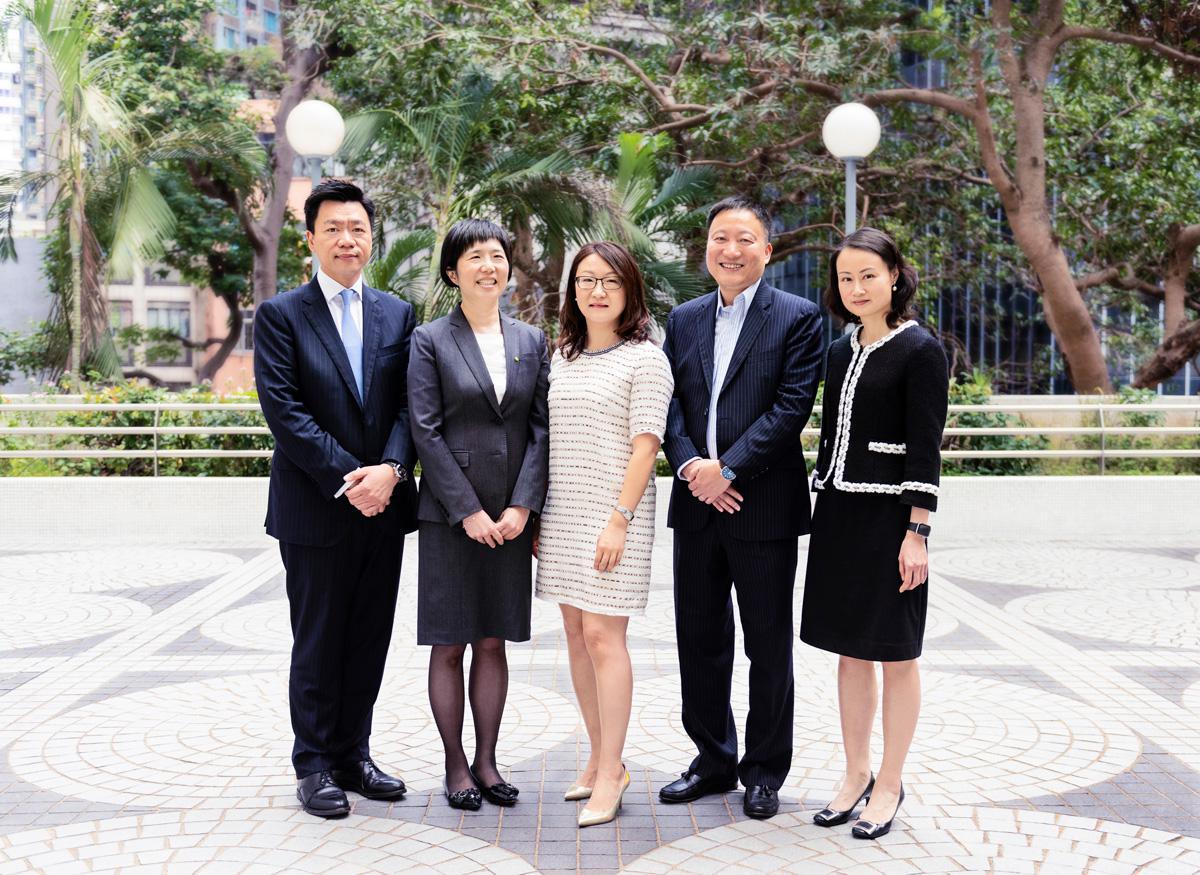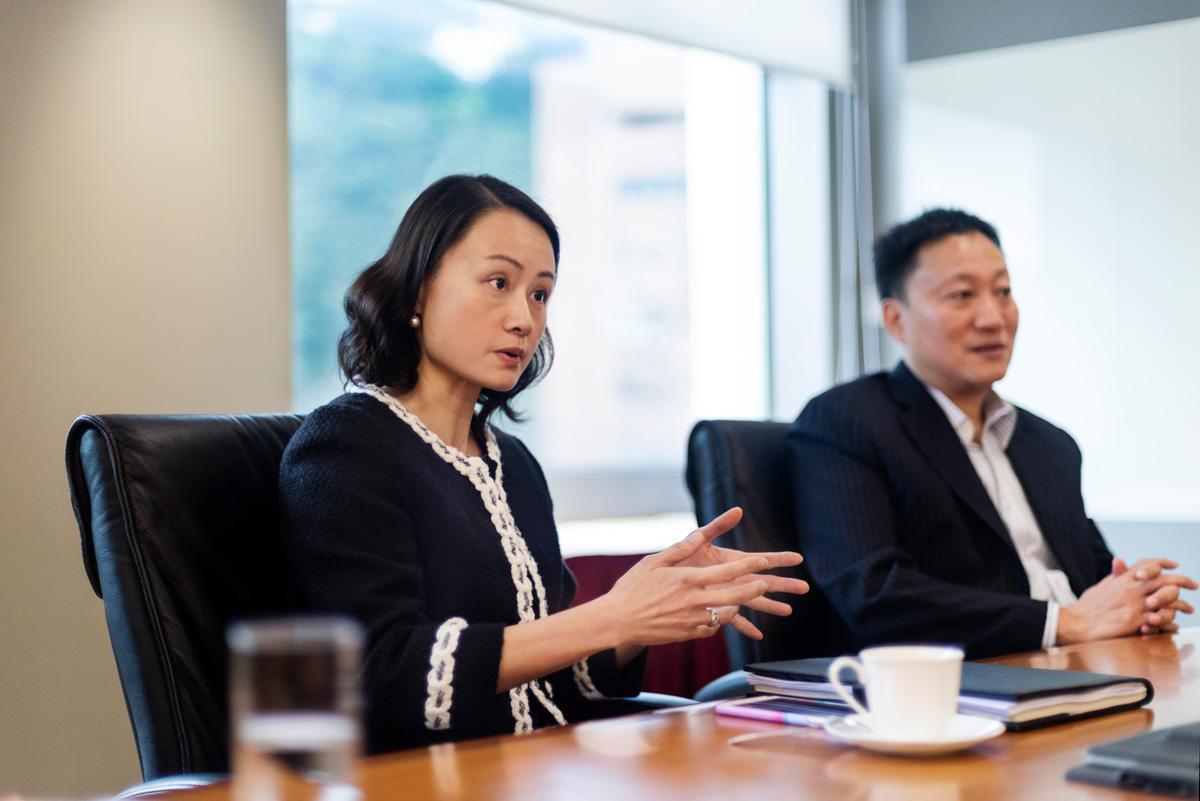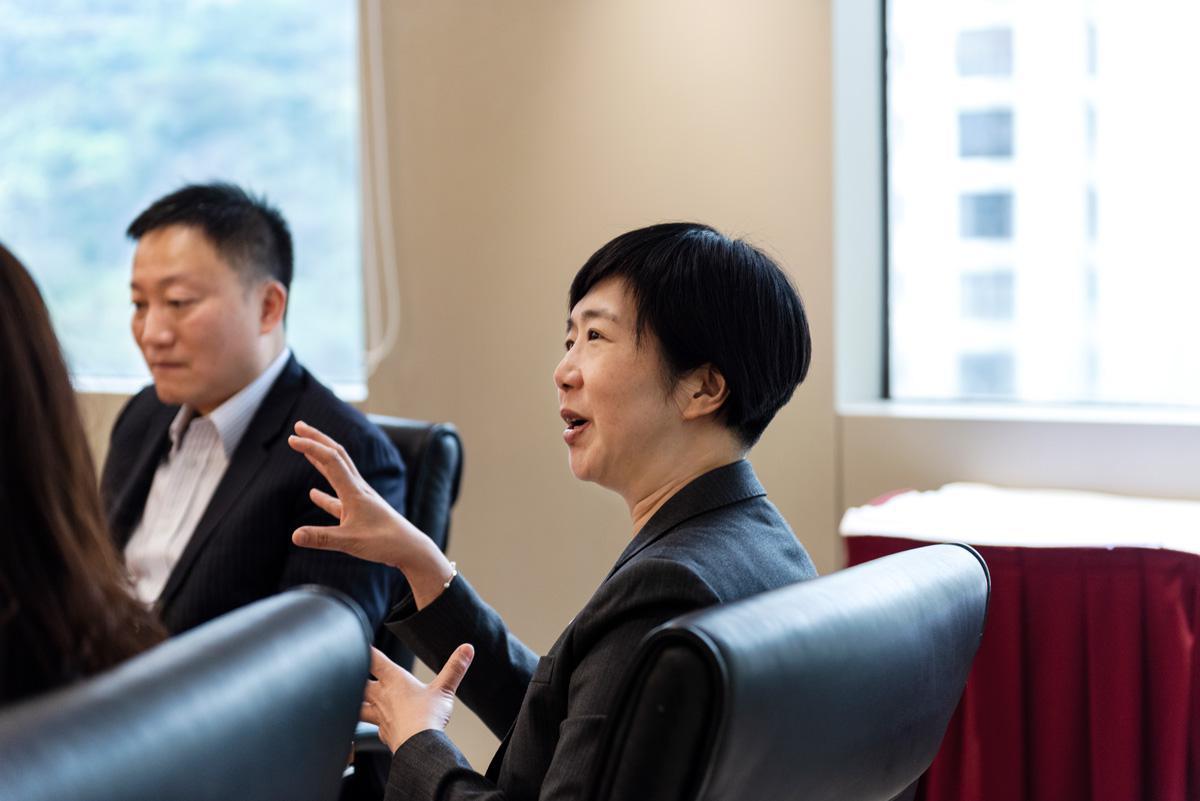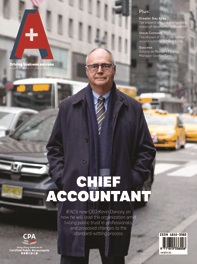The policy measures promulgated by the Mainland central government of the blueprint for its Greater Bay Area (GBA) initiative has increased clarity around Hong Kong’s role in the megaproject. The document confirms Hong Kong will retain its current status as the region’s leading financial centre and continue to act as a gateway between Mainland China and the rest of the world.
While the blueprint offers a broad overview of how the GBA will operate, a number of practical details, particularly relating to taxation, still require further implementation details.
The GBA aims to create an economic powerhouse in the region by combining nine Mainland cities with Hong Kong and Macau into an innovation hub. The initiative takes its inspiration from Japan’s Greater Tokyo Area, and the San Francisco Bay Area and New York metropolitan area in the United States.
(From left) Daniel Hui, Ellen Tong, Rebecca Wong, William Chan and Lorraine Cheung.
The 11 cities already pack a significant economic punch with a combined growth domestic product of CNY10 trillion (US$1.49 trillion) in 2017, but the project intends to further accelerate growth in the region.
The blueprint named Hong Kong, Shenzhen, Guangzhou and Macau as being the four key cities – or “growth engines” – for the region’s development. “Each city will have its own special area to focus on to ensure they do not compete with each other,” William Chan, Partner – Tax, at Grant Thornton, says.
Hong Kong has been named as an international finance hub and transportation, logistics and trade centre for the GBA. Shenzhen will lead on innovation, leveraging on its status as a special economic zone, while Guangzhou will act as the provincial capital, and Macau will focus on tourism and cultural activities.
Daniel Hui, Partner, China Tax at KPMG, explains that the blueprint sets out the short-term goal of building a framework for the GBA, including infrastructure improvements, between now and 2022, with the longer-term aim of having the fully-integrated economic system effective by 2035. “Over the long term, the ambition is to create a world-class bay area that is well placed to do business and promote growth – and also be one of the best places in the world for people to live and work,” he says.
“Each city will have its own special area to focus on to ensure they do not compete with each other.”
For Hong Kong, its status as an offshore renminbi (RMB) centre makes it well placed to benefit from the project. Lorraine Cheung, Partner, China Tax and Business Advisory Services at EY, says: “Because Hong Kong is still the largest RMB offshore centre, it has a competitive edge in terms of finance and in helping to facilitate the flow of money into and out of Mainland China.”
This status also means the city can help GBA companies grow their international presence, particularly through the central government’s main external policy – the Belt and Road Initiative. “Hong Kong can be used as an investment centre for Mainland enterprises because we have the professional expertise and the free-trade environment to help companies expand abroad,” Rebecca Wong, Partner, China Tax and Business Advisory Services at PwC, says.
She points out that the blueprint also recommends channelling through Hong Kong funding from overseas that is being invested in start-ups and technology companies in the Mainland. “The blueprint makes it clear that Hong Kong has a role in helping Mainland companies access financing,” she says.
Increasing mobility
The GBA is not only intended to facilitate trade flows between the key cities and beyond, but it also aims to improve the mobility of people.
Ellen Tong, Director, Tax and Business Advisory Services at Deloitte China, thinks Hong Kong will also have a key role to play in attracting talent from overseas, acting as a gateway to the GBA in this respect. “From a mobility perspective, Hong Kong is a world city, so it is easy to attract people from different parts of the world to come and work here. Leveraging its own niche, its history as a globally open city, conveniences and being part of the GBA, Hong Kong is able to attract talent, and provides people with opportunities to work in the GBA.”
In a bid to encourage more people from Hong Kong to take up residence in one of the Mainland cities, the blueprint states eligible people working in the GBA will have the same access to health, education and housing entitlements that Mainland citizens enjoy. The term “eligible” is yet to be defined, but likely means Hong Kong residents given previously-announced similar policies.
More significantly, the Mainland government has also sought to tackle the personal taxation issues that have previously acted as a deterrent to people who were based in Hong Kong but working in the Mainland on either a full-time or part-time basis.
In the first change, it has stated that a visit to the Mainland of less than 24 hours within a day does not count as a full day for the 183-day residency test for Mainland Individual Income Tax (IIT) purposes. Under the second initiative, professionals who are classed as “high-end, urgently needed talent” working in the GBA will be entitled to a subsidy such that they will be subject to IIT at a similar effective tax rate as if they worked in Hong Kong. Furthermore, the subsidy is not counted as taxable income for the employee.
Tong explains that at this stage further details on how the scheme will work have not been given, but the government may make reference to the framework used in both the Qianhai Special Economic Zone in Shenzhen and the Hengqin New Area of Zhuhai. “This means it is possible people may only be subject to tax at 15 percent, which will eliminate one of the hurdles for people from Hong Kong and some other jurisdictions who are hesitant to work in the Mainland due to the higher IIT – which has a top marginal tax rate of 45 percent.”
Hui adds that people will still need to pay tax at the higher rate first, and then claim back the subsidy the following year. “If the new incentive regime follows Qianhai and Hengqin models, there is still an issue over how the additional tax that is paid will be funded – whether a company or individual will pay it first and get the refund. Moreover, it creates uncertainties, inconvenience and additional administrative burden for companies and individuals to claim the subsidies. For example, how would the tax subsidies be claimed if the individual changes jobs during the year?” he says.
It is also unclear if all of the cities will offer the same level of tax rebate or if it will vary. Wong points out that the government needs to define what it means by “high-end, urgently needed talent,” so that people can understand if they qualify.
Corporate taxation issues
While the Mainland government has sought to address issues around personal taxation, there are still a number of issues around corporate taxation that need to be resolved. Chan says the blueprint did not contain concessions in this area, despite the Mainland standard corporate tax rate of 25 percent being significantly higher than Hong Kong’s standard rate of 16.5 percent.
Hui agrees: “From a corporate tax standpoint, we are hoping more preferential policies will be released to attract investment into the Mainland.” He adds that tax incentives could vary to align them with each city’s strategic role in the project, for example, Hong Kong technology companies could be offered tax breaks if they have research and development (R&D) operations based in Shenzhen.
“The blueprint makes it clear that Hong Kong has a role in helping Mainland companies access financing.”
Aside from the higher corporate tax, Chan would also like the Mainland government to take steps to simplify the business registration processes for Hong Kong companies engaging in short-term projects in the GBA. “Certain projects involving a Hong Kong company and a Mainland one may only last a few months, but the whole process of setting up and registering a company may take longer than the actual project, which sometimes leads to lost opportunities,” he says. “A way around this would be to have project-based registrations or temporary-entity registrations for foreign or Hong Kong-based companies that are cooperating with a Mainland company. Once the project is seen to be viable then the temporary registration is converted into a permanent one and a proper entity is then set up.”
Another issue highlighted by Cheung involves film production companies in Hong Kong that are working with partners in the GBA. “They have no obvious mechanism by which they can inject money into their Mainland partner to fund the production, with many companies currently resorting to classifying the money as a service fee,” she says. “Tax costs associated with service fees can be very high, as they can be subject to tax both going into the Mainland and when it comes back to Hong Kong.”
“In the long run, the success of the GBA is not just about growth in the GBA itself, but it is also about helping GBA companies to grow and expand their businesses globally.”
Tong points out that making it easier for companies based in the GBA to get money out of the Mainland could also help to boost growth and international footprints. “In the long run, the success of the GBA is not just about growth in the GBA itself, but it is also about helping GBA companies to grow and expand their businesses globally. With these, the GBA companies will be able to grow bigger and to further innovate and develop,” she says.
Wong agrees, suggesting the government should experiment with easing the foreign exchange controls for companies operating in the GBA. “It is very common in the Mainland for cities to run pilot policy projects, so there are expectations that something could be done in the GBA to overcome these historical challenges,” she says.
Boost for technology companies
Unsurprisingly, given the GBA’s overarching aim of creating an innovation and technology hub, companies in this sector look set to be significant beneficiaries of the initiative. The blueprint sets out measures to strengthen cooperation between the 11 cities in the area of innovation and technology, including giving tech companies in Hong Kong assess to R&D facilities in Guangdong.
While specific details are yet to be given, it also said it would look at ways to facilitate innovation through measures relating to immigration and customs clearance, the flow of goods within the GBA, and increased interaction between technology specialists and academics. Higher education and R&D institutes in Hong Kong and Macau will also be eligible to apply for Mainland technology projects and funding.
Wong welcomed this part of the blueprint, saying: “Right now, it takes a lot of time to complete customs clearances for temporary importation of prototypes and moulds into the Mainland, and applications for work visas for people travelling across the border, which hinders the ability of the two sides to undertake technology and innovation exchange activities.
“We would appreciate if there were improvements to the current import and export arrangements for prototypes across the borders and the visa applications on both sides. This would be similar to the pilot project to make the flow of goods easier between Zhuhai, Hengqin and Macau.”
Cheung highlights that while technology companies will have the option to use Mainland R&D facilities, many of them may prefer to keep their core R&D activities (and intellectual properties) in Hong Kong, especially in places like Science Park and Cyberport, because many start-ups include professors who are linked to one of the universities in Hong Kong.
She also points out that while companies in the sector tend to do the majority of their production in the Mainland, some key production elements that do not require much space is done in Hong Kong. “As you can imagine, supply chains can be rather complicated. But Hong Kong and the Mainland are still in two different customs areas, so when goods flow between them it involves customs duties and value added tax.”
She adds that these issues need to be overcome to enhance the competitiveness of these companies on the international stage.
Opportunities for CPAs
Despite some of the unresolved issues, the initiative still creates significant opportunities for accountants and other professional services providers. Chan points out that with three different tax systems, there will be a lot of work helping Hong Kong and foreign companies doing business in the GBA grasp the tax environment. “As Mainland companies get bigger and expand abroad, Hong Kong professionals will be able to help them with their investment structures and to understand the tax implications of the markets they are going into,” he says.
Hui agrees that Hong Kong tax professionals are well placed to advise Mainland companies that want to invest overseas due to their strong international knowledge.
However, for Hong Kong professional services personnel, such as accountants and lawyers, to work in the GBA, there would need to be some form of mutual recognition of qualifications.“For legal professionals, it generally takes close to a year or more to get approval from the Ministry of Justice. Companies in the technology industry need to get advice from legal professionals specializing in intellectual property, patents and copyright,” Tong says. “It would be good if the authorities could introduce a ‘fast pass’ for these professionals to work in the GBA.”
Certain groups of professionals, including accountants, are also still only able to operate as joint ventures in the Mainland, meaning they still need to find local partners before they can open branches in the GBA.
As Cheung puts it: “There are a lot of opportunities at a strategic level but at the implementation level rules and regulations still need working out.”



















